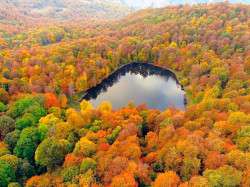Gosh Lake
The village, the monastery, and the lake were named after an Armenian writer, thinker, and public figure Mkhitar Gosh. The surface area of the lake is 0,008 square km, max width is 80 meters, while max length is 100 meters. The max depth of the lake is 8 meters, the water volume is 1,500 cubic meters. The inflow of Gosh Lake is supplied by springs, as well as rain and snow. In summer, the temperature of the lake’s surface is only 14 °C.The surroundings of the lake resemble a residence of gods: maybe, this is in fact the heaven that has been long searched for. In any case, the mere view of this unique sight evokes indescribable feelings. Stumbling upon such enchanting beauty, calmness, and natural splendor is truly an event of the greatest rarity.In the surroundings of Gosh Lake, one can see various handmade monuments, as well as natural rock formations and mineral springs.Unfortunately, Gosh Lake today stands in a poor condition as it slowly turns into a swamp. Ecologists carefully observe the lake.The village Gosh located in the Tavush Province of Armenia. It is named after Mkhitar Gosh who took part in the re-building of the older monastery of Nor Ghetik during the 12th-13th centuries, which had been destroyed by an earthquake in 1188. The newly built monastery was later named Goshavank in honor of Mkhitar. Goshavank is located just off the main highway that runs through town. On a hillside west of the monastery complex sits a chapel that also serves as the tomb of Mkhitar Gosh. It was situated to overlook the monastery in which he helped build. The chapel is square in plan with a single centrally located dome above and one portal. Nearby are the ruins of what are said to be Mkhitar's house. Stone foundations and low walls still exist.

